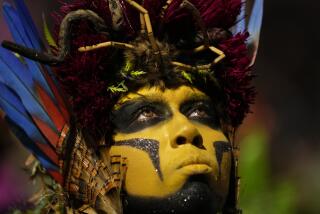Brazil’s Yanomami Caught in Fight Over Gold, Diamond Deposits : Civilization Threatens Largest Primitive Indian Tribe
- Share via
BOA VISTA, Brazil — Bitter disputes over gold and diamonds involving miners, priests and soldiers are endangering the lives of the Yanomami Indians, the largest primitive tribe in existence.
The Indians are threatened by a gold rush atmosphere in the remote northern Brazilian territory of Roraima, a region about the size of Minnesota, where a statue of a gold miner is the only monument gracing the tiny of capital of Boa Vista.
Most of the gold, diamonds and minerals are buried where 9,000 Yanomamis live, spread out in four groups along the savanna clearings of the tropical Amazon rain forest and its border with Venezuela. An equal number of Indians inhabit the Venezuelan side of the frontier.
Shun Clothes, Paint Bodies
It’s believed the Yanomamis migrated from the Caribbean region thousands of years ago. Because they burn their dead and drink a solution of the ashes, evidence of them in Roraima traces back only 120 years.
The Yanomamis hunt with poisoned arrows, and many use primitive tools. They shun clothes, decorate their bodies with fruit dye and flowers and live under huge palm huts in communities of 50 people.
Anthropologists, the Roman Catholic Church and Indian-rights groups fear that forced acculturation by an onslaught of whites will further reduce the Yanomami population, largely through disease.
Besides not doing much to stop thousands of itinerant gold prospectors from flocking to Roraima, the government plans to settle and guard 4,000 miles of Brazil’s northern frontier against drug trafficking, gold smuggling, border disputes and foreign leftist guerrillas, mainly from Colombia.
New Army Outposts
This calha norte, or northern ridge project, involves new army outposts, and they have brought hundreds of soldiers and families to Roraima, which has a population of 100,000.
The Yanomami is the largest tribe with little or no contact with the modern world.
Because of their isolation, the Indians have no immunity against common viruses and can easily die from flu or a cold. That’s the main reason the number of Brazilian Indians shrank from 5 million when the Portuguese reached Brazil in 1500 to 220,000 today.
“The Yanomamis will not be killed by arms but by bacteria,” said anthropologist Alcida Ramos, who has lived with the Yanomamis and has written extensively about them.
Armed violence has also become a growing threat. In late August, four Yanomamis were killed in a sketchily reported confrontation in which a gold prospector died and another was wounded.
Archdiocese Claim
The Archdiocese of Roraima said the miners shot, stabbed and mutilated the Yanomamis.
Raimundo Teixeira, who heads a miners’ cooperative in Roraima, said the Indians were incited to attack by priests and missionaries “who smuggle out gold and use the Indians as slaves.”
To solve the problem, the government Indian agency, known by its Portuguese initials as Funai, sent in soldiers and helicopters to throw out both miners and missionaries.
“The church is accused of smuggling gold, diamonds, precious stones and dollars,” said the Rev. Aldo Mongiano, an Italian who is the bishop of Roraima. “The only thing we haven’t been accused of is drug trafficking, but I’m sure that’s next.”
Mongiano and all other priests have been banned by the Indian agency from visiting the Yanomami area. So have medical teams and missionaries giving assistance to the Indians.
Dr. Maria Gorete Selau said she was treating 100 Indians who had malaria before she was prohibited from entering the region.
“They were recovering from the flu, and now they are dying of malaria,” she said.
Funai official Esmeraldino Silva Mendes, however, said the agency is providing adequate health care.
Today, only the military and Funai personnel are officially allowed to enter the region. That is not keeping out the prospectors.
Funai repeatedly denied requests by the Associated Press to visit its Yanomami post, saying it was unsafe.
There are strong feelings against foreigners in Roraima, and many priests in the archdiocese are Italian, including the bishop.
The only organization actively lobbying to create a national park for the Yanomamis is run by a Swiss-born woman and is financed by Norway through the Denmark-based International Work Group for Indigenous Affairs.
The influential newspaper O Estado de Sao Paulo published stories alleging that foreign plots were afoot to sell out Brazil to multinational mining companies, using the Indians as “front men.”
The reports, without attribution, resulted in an investigation of the National Indigenous Missionary Council, an Indian-rights group linked to the National Bishop’s Conference, the main coordinating body of the Roman Catholic Church in Brazil.
A senate committee labeled the accusations unfounded.
Claudia Andujar, who coordinates the commission to create the Yanomami park, has been lobbying for 10 years to have Funai mark off 9 million acres--a sixth of Roraima--for the Indians.
“It’s obvious that what we’re up against are many special interests, mainly mining companies wanting their hands on the resources,” she said.
Andujar cannot get inside the Yanomami area or persuade officials to let in doctors.
The government National Security Council lists Bishop Mongiano as one of 118 foreign priests breaking a Brazilian law forbidding involvement in domestic affairs. He faces possible expulsion.
Church Targeted
“The right wing has decided to turn the church into Public Enemy No. 1,” Sen. Severo Gomes said. “It’s like the Inquisition, with lists and no proof. Suddenly the church can’t get involved because it’s seen as subversive.”
Gomes said the accusations against Indian-rights groups “are targeted to confuse public opinion at a time when congress is writing a new constitution that could change laws about mineral development.”
Gomes introduced legislation that would limit prospecting to government companies, excluding all private ventures, Brazilian and foreign. It also would require congressional and Indian approval before Indian land is explored for minerals. Although that probably would help, it wouldn’t keep away civilization.
The northern ridge military project calls for six army posts in Roraima, each with a platoon of 60 soldiers and their families. Three posts are already functioning.
“I am here to keep the prospectors away from the Indians, to preserve mineral resources, prevent miners from extracting gold and preserve Brazilian unity,” Lt. Adalberto Antonio de Faria said.
What do the Yanomamis think of all this?
Army Keeps Its Distance
Since the missionaries were thrown out, the people who speak Yanomami haven’t been able to ask. A spokesman for Funai said, “There is not one complaint against us.”
The army says it keeps its distance and respects the Indians, only making contact when the Yanomamis approach them.
By all accounts, many Indians are aware that they are sitting on a gold mine. Indeed, many of them are known to pan for gold, which is usually exchanged for cheap trinkets such as fish hooks and bracelets.
The national Coordination Board of Geologists, which has 7,000 members, has recommended that the Yanomami area be kept as a government-protected preserve.
Rampant Smuggling
The group said that two-thirds of the estimated 1,900 pounds of gold and 90% of the estimated 50,000 carats of diamonds found annually in Yanomami territory are smuggled out of Brazil. It argued that uncontrolled prospecting there is not beneficial to the nation as a whole.
The geologists said the Yanomamis’ land does contain important deposits of cassiterite, or tin ore, but that Brazil has 20 years’ worth of reserves elsewhere and does not need to disrupt the Indian area now.
“The history of mineral extraction in the Yanomami area shows the mineral wealth benefits only a small group of people,” the group’s study concluded.
“Brazil does not need the Yanomami area for minerals at present,” said Wanderlino de Carvalho, president of the geologists’ organization. “It should remain a preserve in case we really do need it someday.
“What is more important is not to shock the Yanomamis into extinction.”
More to Read
Sign up for Essential California
The most important California stories and recommendations in your inbox every morning.
You may occasionally receive promotional content from the Los Angeles Times.










